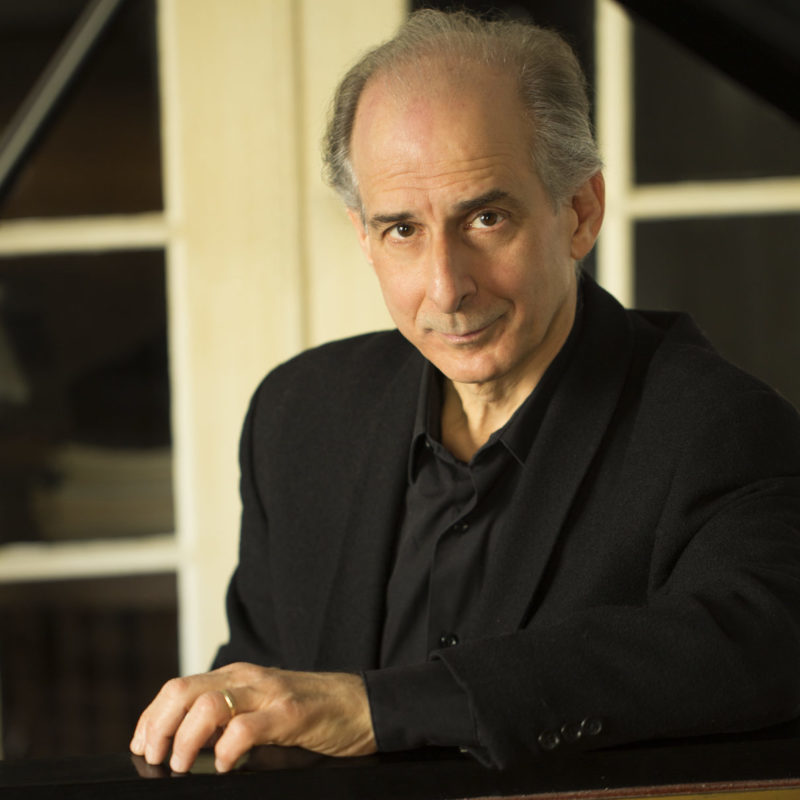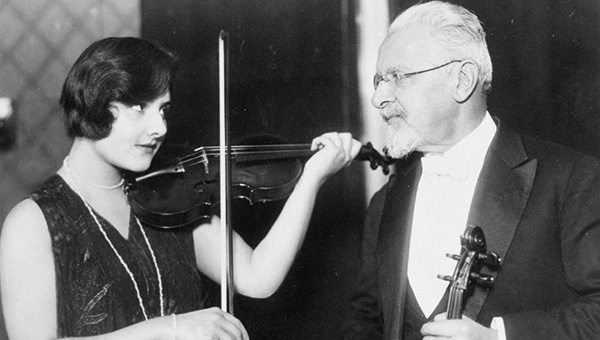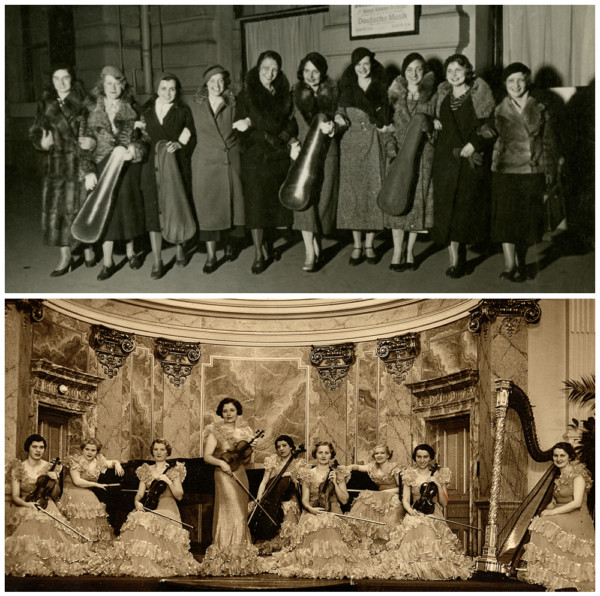
In this ROCOInsider, we had a chance to chat with composer Bruce Adolphe, ahead of a very special world premiere commission Saturday – beginning a triptych of works we’ll present this season honoring three women musicians of the Holocaust. I Too Bleed, and Hope for Beauty tells the story of violinist Alma Rosé, credited with saving the lives of her orchestra, through her steadfast leadership and unbreakable spirit.
Read on to learn more about Alma and discover how Bruce musically tells her story, how he got into composing, and – how he became the “Piano Puzzler” guy!
This will be the first time we’ve worked with you on a commission, but not the first time we’ve played your music – how did this collaboration come about?
In 2017, I learned that ROCO would be performing my violin concerto I Will Not Remain Silent, and had a chance to catch the livestream – I was absolutely blown away! I immediately got in touch with Alecia Lawyer, and that started the chat about us working together in the future.
The violin concerto is a piece with a fascinating story – based on the life of Rabbi Joachim Prinz, who was in Berlin during the Nazi period and then escaped to settle in the United States, where he became very involved in the world of Civil Rights-era America and Martin Luther King.
This kind of inspired the thought that we would work on something together having to do with the Holocaust, and it would also be good timing, with Holocaust Museum Houston completing an expansion and reopening right before the start of Season 15.
We’ll hear two more new works from you in March, for chamber ensemble and solo instrument – forming a triptych centered on this theme, as our composer-in-residence “ROCO-style” this season. How did you come to the idea of focusing on the stories of three women musicians of the Holocaust?
We explored several ideas of aspects to examine through the triptych, when I found a video about pianist Alice Herz-Somner (who lived to be 110 and only passed away recently) – and it was quite amazing to hear her play, and to hear her forgiveness for everyone – even for those who imprisoned her, who took away her career, who killed her family. It was almost as if, if she didn’t have this forgiveness – emotionally, she would just die. So she was an incredibly inspiring, and also alarming, figure.
This led me to investigate other musicians of the Holocaust, and to learn more about Anita Lasker-Wallfisch, and Alma Rosé, who I had previously known about mostly just through the film which was made about her life – “Playing For Time” in the 1980s. This film, however, portrayed a rather inaccurate version of her, colored by the opinion of only a few, and research has revealed she actually was a much more complex figure, leading to a wonderful book about her – Alma Rose: From Vienna to Auschwitz.
Who was Alma Rosé – in a nutshell?

Credit: Haus der Musik Innsbruck
Alma was essentially born into the musical royalty of Vienna at the time – her father Arnold Rosé, who had been concertmaster of the Vienna Opera Orchestra and led the Rosé Quartet for decades, and her father’s brother Edward, each married a sister of composer Gustav Mahler. And her father and uncle both played chamber music with Brahms – in fact, Alma grew up calling Brahms “uncle” too!
Alma turned out to be an immensely talented violinist and built a highly successful career, founding her own women’s orchestra, who toured all across Europe. With war looming, Alma and her father Arnold escaped to London, and then she continued by herself to the Netherlands, hoping to resume her musical career. But she was eventually arrested in late 1942 and ends up being deported to the camp at Auschwitz in 1943. At Auschwitz, word spread quickly that Alma was a famous violinist, and she was soon made the leader of the women’s orchestra there.
Through her leadership of the orchestra, Alma is credited with saving the lives of an astonishing 48 women. Why was the orchestra so important to the SS officers? And how did music help Alma deal with the experience of Auschwitz?
As soon as Alma got there, she worked on raising the standard of the orchestra as much as possible – because the better they performed, the more valuable they were, and less likely to be killed.
It’s important to remember the SS officers were people too, and that people are in essence, really complicated – and good people can become monsters. For these officers, it was a release to hear music played, they loved it. Of course, there’s a story of a female guard who was extremely moved by a piece the orchestra played, was very friendly to the musicians – then kicks an old woman down on the way out. I don’t know how these guards and officers could do these things, day after day, and then go home to their families.
For Alma, the world around her was so terrifying at that moment, that playing music offered a combination of both escaping and confronting the situation at the same time – because she could escape through the music in her mind, but she also used the music as a tool to confront and conquer it. She truly dedicated all she had to drilling and rehearsing this orchestra because she knew this was the only way she could help to keep herself, and these women, alive.
Tell us about the title of the piece – inspired by a quote from one of her fellow prisoners?
A Slovak doctor in the camp, Manca Švalbová, was a close friend of Alma’s, who listened to her perform a lot – and described her playing as if her violin was speaking when she played, saying “I too bleed, and hope for beauty”.
How do you musically communicate Alma’s story in this piece? What themes, or elements, should we listen for?

Credit: Gustav Mahler–Alfred Rosé Collection, Music Library, Western University, London, Canada
Well, you will certainly hear a few violin solos, and that’s definitely in tribute to her – some of them have a Jewish inflection, and they come at the beginning, the middle, and near the end. Aside from the violin solos, there are also these almost dreams, or hallucinations, of waltzes that appear – which are not normally part of my composing world – but which were an important part of Alma’s life, as the orchestra she had before being captured were the “The Waltzing Girls of Vienna” (Die Wiener Walzermädeln). The fragments are quite ghostly, and not specific melodies from the time, but there is a moment where – there is a quote of a real Strauss waltz but framed by silence, followed by an eerie chord from the strings, then the quote returns in the flutes, unfinished – then the orchestra comes crashing back in. I think it’s going to be very powerful.
There’s also music that moves by in an almost mechanical way, rhythmically ticking along – meant to convey the idea of inevitability, of the Nazis’ Final Solution, but it gets interrupted a lot with disturbing, violent outbursts. There’s also quite a bit of lyrical, almost nostalgic music though – giving the feeling she must have had, thinking back to her life before it all happened.
What is your process of composing?
The first step is to imagine the piece, to see it almost like a dream – without a keyboard, computer or paper nearby, trying to hear the piece as if I’ve just walked into the concert hall. I don’t always get the strongest ideas here, but it’s an important step. Then I go to the piano and improvise on these, I may do this for an hour and only keep a bit of it – but then be walking down the street later, and a great idea hits me of what direction I’d like to take. Once I have these ideas going, then I’ll use my keyboard, hooked up to my computer, to start getting it down as music and keep the creative juices flowing. I never censor any of my ideas at first, until I’ve written a lot, and then I go back and edit and make cuts as if I’m someone else listening to the work.
Since our season theme is Coming Of Age – tell us a bit of your own coming-of-age story as a musician? Was there a defining moment in which you knew composing is what you wanted to do?
It really all started very young. Though my first piano teacher and I actually didn’t get along that well – he wasn’t great with kids, and I never wanted to play what I was assigned. In fact, he had the nerve to tell my parents that I didn’t have any talent and shouldn’t continue with lessons!
But they knew better – because at home on the piano I played things from the radio all the time, just improvising. So thankfully, they found another piano teacher. She had a little trouble with me though because I kept adding my own stuff to all the pieces I was learning!
I just thought composing was a normal thing to do as a kid, and around when I was 7 my teacher started encouraging me to write things down. By the time I was 10, it turned into formally composing.
As a preteen, I began to study with composition teachers and then was accepted into the Juilliard School’s pre-college program, where I took composition lessons from Lawrence Widdoes. He did a fun exercise where he had two pianos in the room, and we would have musical “conversations” – he’d improvise something, and I’d respond. So these duo improvisations were a way of exploring ideas.
I later went on to receive my Bachelor’s and Master’s degrees from Juilliard, studying with composer Milton Babbitt for two years, and I began to have success making a living as a composer – writing for a lot for theatre, and short film scores, plus composing my own chamber and orchestral music.
For those who listen to public radio, they may recognize your name – from the Piano Puzzlers you create, heard on Performance Today! How did you get into doing these?
I had begun teaching in the Juilliard pre-college program myself when I was 19, and I always wanted to find a way to entertain my classes and have them enjoy theory – so if we were looking at say, a piece by Mozart, I would play a tune they knew in the style of Mozart, and have them guess what it was. I would then give assignments to take a folk tune, and write it as if it were Brahms or Beethoven, etc., and I would always do these assignments along with them too.
In 1992, I was hired to give pre-concert lectures at the Chamber Music Society of Lincoln Center (and I’m still there!) I thought – how can I connect with everyone in such a diverse audience, and realized entertainment and humor was a great common denominator. The program might have music by Bach, Stravinsky, etc., so I would take a melody from one piece and would play it in the style of other composers on the program. The popularity of these lectures really grew, and one day a representative from NPR was in attendance and asked if I’d like to do this on the radio.
After my first Piano Puzzler broadcast, so many listeners called in to respond, that they just continued – and now it’s been 18 years!
Any advice to composers out there currently working to develop a career – on how to keep it fun while in the grind?
The main thing is to always think about your own relationship with the music. I think sometimes there’s too much emphasis on music as a career, as opposed to music as an art. The more one is devoted to developing real skills, and exploring your own personal life in music, then it becomes a real adventure, rather than just – how do I make a living.
It has to be about your love of music, and about your work – and you have to work really hard at the music, not at the career. It only matters if it’s really genuine.
My biggest advice is to keep learning everything you can about composing, continue to explore, and don’t give up on the craft. It’s a lifelong study of how to get better and better. Even the great composers, such as Schubert – in the months before he died, he was still taking counterpoint lessons. And Haydn, even in his 70s, had examples of composition exercises he would do for fun to challenge himself.
It’s much more fun to think of it as a neverending journey – each time I write a piece, still, I feel like I have new questions I’m answering.
Hear the world premiere of “I Too Bleed, and Hope for Beauty” – in ROCO In Concert: Hope For Beauty, on Saturday, November 16, 2019, 5:00 pm, at The Church of St. John the Divine. Tickets available at roco.org, or at the door.

Leave A Reply